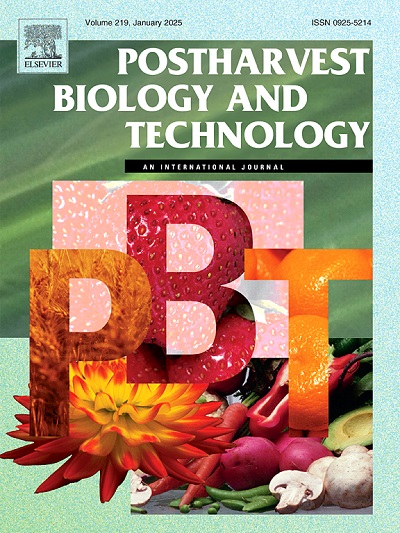Characterization of Lasiodiplodia brasiliensis causing banana black rot in Korea and its biocontrol by Paraburkholderia busanensis P39 through volatile-mediated microbiome modulation
IF 6.4
1区 农林科学
Q1 AGRONOMY
引用次数: 0
Abstract
Post-harvest diseases significantly reduce fruit quality and storage longevity, necessitating sustainable management strategies. In this study, we identified Lasiodiplodia brasiliensis as the causative agent of black rot in bananas in South Korea, marking the first confirmed report in the region. Morphological and multi-locus phylogenetic analyses were performed for precise species identification. Given the increasing need for biological control solutions, the antagonistic activity of Paraburkholderia busanensis P39 against L. brasiliensis was investigated through direct and volatile-mediated interactions. Dual-culture assays demonstrated strong antifungal activity of P39 against the pathogen, whereas mycophagy assays further revealed its ability to exploit fungal mycelia as a nutrient source. In addition to direct inhibition, P39 volatiles significantly suppressed black rot symptoms in bananas without physical contact and effectively extended the fruit shelf life. A microbiome analysis of banana peels treated with P39 volatiles was performed to elucidate the underlying mechanisms. Metabarcoding of the bacterial and fungal communities revealed distinct microbial communities, including the enrichment of Paraburkholderia and suppression of spoilage-associated bacteria (Pseudomonas and Enterobacter). Fungal community analysis indicated a significant increase in the abundance of yeast-like fungi, suggesting a microbiome-mediated contribution to fruit preservation. Correlation analysis further supported the role of P39 volatiles in the restructuring of microbial interactions, leading to enhanced disease suppression and delayed ripening. These findings highlighted the dual functionality of P39 volatiles in pathogen inhibition and fruit preservation, positioning them as promising residue-free alternatives for post-harvest disease management. This study provides critical insights into the microbiome-driven mechanisms underlying biological control and offers a foundation for the development of microbial-based post-harvest preservation strategies.
韩国香蕉黑腐病病原菌的鉴定及busanparaburkholderia P39的挥发性调控
收获后病害显著降低果实品质和贮藏寿命,因此需要可持续的管理策略。在本研究中,我们鉴定出巴西黑腐病Lasiodiplodia brasiliensis是韩国香蕉黑腐病的病原体,这是该地区首次确认报告。形态学和多位点系统发育分析进行了精确的物种鉴定。鉴于对生物防治方案的需求日益增加,本研究通过直接和挥发物介导的相互作用研究了busanparaburkholderia P39对巴西乳杆菌的拮抗活性。双培养实验表明P39对病原菌具有较强的抗真菌活性,而真菌吞噬实验进一步揭示了其利用真菌菌丝作为营养来源的能力。除直接抑制外,P39挥发物在无物理接触的情况下显著抑制香蕉黑腐病症状,有效延长水果保质期。用P39挥发物处理香蕉皮进行了微生物组分析,以阐明潜在的机制。细菌和真菌群落的元条形码显示了不同的微生物群落,包括副aburkholderia的富集和腐败相关细菌(假单胞菌和肠杆菌)的抑制。真菌群落分析表明,酵母样真菌的丰度显著增加,表明微生物组对水果保存的贡献。相关分析进一步支持P39挥发物在微生物相互作用重组中的作用,导致疾病抑制增强和成熟延迟。这些发现强调了P39挥发物在病原菌抑制和水果保存方面的双重功能,将它们定位为收获后疾病管理的有前途的无残留物替代品。该研究为微生物组驱动的生物控制机制提供了重要见解,并为开发基于微生物的收获后保存策略提供了基础。
本文章由计算机程序翻译,如有差异,请以英文原文为准。
求助全文
约1分钟内获得全文
求助全文
来源期刊

Postharvest Biology and Technology
农林科学-农艺学
CiteScore
12.00
自引率
11.40%
发文量
309
审稿时长
38 days
期刊介绍:
The journal is devoted exclusively to the publication of original papers, review articles and frontiers articles on biological and technological postharvest research. This includes the areas of postharvest storage, treatments and underpinning mechanisms, quality evaluation, packaging, handling and distribution of fresh horticultural crops including fruit, vegetables, flowers and nuts, but excluding grains, seeds and forages.
Papers reporting novel insights from fundamental and interdisciplinary research will be particularly encouraged. These disciplines include systems biology, bioinformatics, entomology, plant physiology, plant pathology, (bio)chemistry, engineering, modelling, and technologies for nondestructive testing.
Manuscripts on fresh food crops that will be further processed after postharvest storage, or on food processes beyond refrigeration, packaging and minimal processing will not be considered.
 求助内容:
求助内容: 应助结果提醒方式:
应助结果提醒方式:


